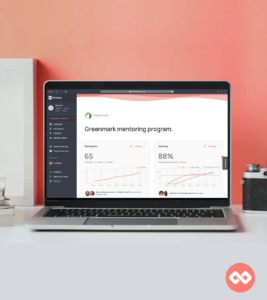It’s becoming increasingly important for organizations to invest in the growth and development of their employees. One powerful way to do this is by fostering a culture of mentoring within your company. By embedding mentoring into your company’s DNA, you can unlock a wealth of benefits and create a supportive environment where employees can thrive.
We often talk about building a culture of mentoring here at Mentorloop, but why and how should your organisation go about it? Let’s first take a look at the many benefits of this type of culture, and then look at how exactly you can start cultivating it in your own workplace!

The Benefits of a Culture of Mentoring
Why should you care about fostering a culture of mentoring? As Lois J. Zachary writes in her book Creating a Mentoring Culture, embedding mentoring in your culture can have some profound effects, including:
- Establishing ownership
- Promoting shared responsibility
- Maximising resources
- Maintaining integrity
- Facilitating knowledge utilisation
- Supporting integration of key processes into the organisation
- Creating openness to learning through mentoring
- Shortening ramp-up time
And the benefits don’t end there. Mentoring has also been found to ensure psychological safety in the workplace, meaning team members can trust each other to experiment without judgement, voice opinions without being shamed, and fail without being labelled a failure.
Mentoring provides individuals with the invaluable opportunity to learn from those who have already walked a similar journey. As a result, the benefits are numerous.
A strong mentoring culture enhances employee engagement and retention. When employees feel supported and guided on their career journey, they’re more likely to stay committed and invested in the long run. This leads to higher job satisfaction and a lower turnover rate, which, in turn, results in cost savings for the company.
Mentoring also has a profound impact on employee development. It accelerates learning and personal growth by providing individuals with real-world insights and practical advice. Through mentoring, employees can avoid potential pitfalls and learn valuable lessons from experienced mentors who have been there, done that.
Moreover, a culture of mentoring promotes knowledge-sharing and collaboration within your organization. When employees have access to mentors, they can tap into a vast wealth of knowledge and expertise that might otherwise go untapped. This creates a more dynamic and innovative work environment where ideas are exchanged freely, fostering creativity and boosting productivity.
Furthermore, a culture of mentoring fosters a sense of community and belonging among employees. When individuals have mentors who genuinely care about their growth and well-being, they feel valued and supported. This sense of belonging can lead to increased loyalty and a stronger sense of commitment to the organization.
Mentoring can also help to bridge the gap between different generations in the workplace. With the rise of multigenerational teams, having mentors from different age groups can facilitate understanding and collaboration. Younger employees can benefit from the wisdom and experience of older mentors, while older employees can gain fresh perspectives and insights from their younger mentees.
Furthermore, a culture of mentoring can have a ripple effect throughout the organization. When employees experience the positive impact of mentoring, they are more likely to pay it forward and become mentors themselves. This creates a cycle of continuous learning and development, where knowledge and expertise are passed down from one generation to the next.
Lastly, a culture of mentoring can also contribute to diversity and inclusion initiatives within the organization. By pairing mentors and mentees from different backgrounds, organizations can foster a more inclusive and equitable work environment. Mentoring relationships can help break down barriers, challenge biases, and promote understanding and empathy among employees.
But a culture of mentoring doesn’t happen overnight; it’s something that happens gradually and can be encouraged with a few strategies and tips.
Building a Culture of Mentoring
How exactly can you go about building a culture of mentoring? Here are some steps we recommend you follow when first starting out.
Acquire Leadership Buy-In
Your program won’t get off the ground if you don’t have support from the top. As you would with any other initiative, make sure your C-Suite is on board before moving forward. So the first crucial step in building a culture of mentoring is to gain support from senior leadership. When leaders champion mentoring, it sends a powerful message to the rest of the organization and sets the stage for success. So seek their endorsement and emphasize the positive impact mentoring can have.
Need some help convincing them? According to Development Dimensions International (DDI), when asked to identify the most pressing issues facing them today, the C-suite overwhelmingly responded it was 1. developing “next-gen” leaders (64%), and 2. a failure to attract/retain top talent (60%). Lucky for you, a mentoring program can help with both. Leadership buy-in is not just about obtaining verbal support; it also involves securing the necessary resources and allocating a budget to support the mentoring program. By investing in mentoring, leaders demonstrate their commitment to employee growth and development.
Establish Accountability
Who will be responsible for your mentoring program? Make sure you assign a Program Coordinator or even a team to manage the admin and participant support needed to run a successful mentoring program. Making someone the point person will ensure your program doesn’t just get off the ground, but that it continues to keep your participants engaged while hitting its targets.
Read: What Does a Program Coordinator Do?
Make It Accessible
Ensure your program is open to as many people as possible. In other words, if a team member wants to participate, they should be able to sign up and get started easily and without too much back-and-forth.
Provide a platform or system that makes it easy for employees to connect and communicate with potential mentoring partners. Make sure the process is streamlined and user-friendly to encourage active participation.
On Mentorloop, we make it easy for Program Coordinators to make their programs accessible to as many people as possible, as easy as possible by giving them options when it comes to inviting participants.
Consider implementing a mentorship matching system that uses algorithms to pair mentors and mentees based on their goals, interests, and expertise. This not only simplifies the process but also increases the likelihood of finding compatible mentor-mentee pairs.
Be Clear On Goals And Participants’ Responsibilities
Clearly defined goals serve as the compass guiding the mentoring program, ensuring that both mentors and mentees understand the purpose and expected outcomes. Whether the focus is on career development, skill enhancement, or knowledge transfer, articulating specific, measurable objectives provides a roadmap for success. This clarity not only helps participants align their efforts but also enables the organization to assess the effectiveness of the mentoring initiative, making it an integral part of its overall strategic vision.
Equally essential is establishing clear responsibilities for participants in the mentoring process. Defining the roles and expectations of both mentors and mentees sets the groundwork for a successful and mutually beneficial relationship. By outlining these roles, the organization creates a structured framework that fosters accountability and ensures that the mentoring program becomes ingrained in the company’s DNA, contributing to a culture of continuous learning and professional development.
Have An Open Feedback System
An open feedback system means you’ll be able to constantly iterate and improve your program. This openness creates an environment where participants feel comfortable sharing their experiences, challenges, and suggestions, fostering a culture of continuous improvement. By collecting feedback, you can identify areas of strength and areas that may need refinement, enabling them to adapt and enhance the mentoring program to better meet the evolving needs of both mentors and mentees.
Moreover, an open feedback system promotes a sense of ownership and engagement among participants. When individuals see that their opinions and insights are valued, they are more likely to actively contribute to the success of the mentoring program. This inclusivity reinforces the idea that mentoring is a collaborative endeavour where the voices of all participants matter. It not only strengthens the mentor-mentee relationships but also contributes to the overall cultural shift towards prioritizing mentorship as a strategic element of professional growth within the organization’s DNA.
Mentorloop’s Sentiment Feedback Analysis System helps mentoring program coordinators stay on top of participant feedback and give them actionable data to help improve their program. The best part? All of this is surfaced for you in real-time via the Live Program Dashboard!
Share Stories From Your Mentoring Champions
Find your mentoring champions and then use their stories of success! These people will be in a position to influence, encourage, and motivate others to get involved in your mentoring program, and their stories can be powerful.
By actively seeking out individuals who have experienced tangible success through mentoring relationships, you can leverage their stories as powerful testimonials. These champions serve as living proof of the program’s impact, illustrating the transformative power of mentorship on professional growth and career trajectories. Sharing these success stories not only highlights the program’s efficacy but also provides relatable narratives that resonate with potential participants. When others see firsthand the positive outcomes achieved through mentorship, they are more likely to be inspired to engage in the program themselves, creating a ripple effect that amplifies the culture of mentoring within the company.
At Mentorloop, we help you easily find your mentoring champions and share their stories
Communicate The Program’s Progress & Success
And we mean everyone—not just leadership. Just like many things, if your mentoring program is out of sight, it’s out of mind. Keep it on top of everyone’s minds by regularly sharing how the program is progressing and the real-life benefits it’s creating!
By openly celebrating achievements like program growth milestones and recognizing the efforts of mentors and mentees, you not only motivate current participants but also attract potential contributors, fostering continuous engagement. Transparent communication builds awareness and understanding across the organization. This clarity helps overcome resistance and instils confidence in the program’s value, gradually assimilating mentorship into the company’s identity. Additionally, sharing success stories alongside program data creates a narrative that positions mentorship as a norm, shaping a cultural shift where it becomes an integral element of everyday professional development and growth within the organization.
Mentorloop makes this easy for Program Coordinators by not only surfacing data on your Live Program Dashboard, but also turning your real-time data into beautiful reports that are ready for sharing.
Learn more about Reporting and Analytics on Mentorloop:
Hit the Ground Running
If you want to hit the ground running, we’d like to offer a few additional tips.
First and foremost: Start small with a pilot program. Organisations that have a culture of mentoring—and a massive program to go with it—didn’t start that way! A pilot program will give you a proof of concept in three or six months.
Once your program is up and running, recruit participants in waves, gradually adding regions and/or departments. This can be done via open enrollment, on-off recruitment, and in cohorts. Want to see how these types of recruitment work in action? Download our three sample mentoring program timelines.
Last but not least, once people have a participant profile, they can always dip in and out, but a great way to get them in in the first place is to encourage them to sign up during your organisation’s onboarding process.
Ready to take the first step? Mentorloop is here to help you run your program so you can focus on the important task of building a mentoring culture within your organisation.




